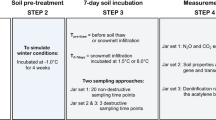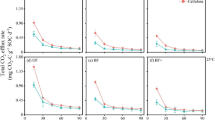Abstract
We tested a conceptual model describing the influence of elevated atmospheric CO2 on plant production, soil microorganisms, and the cycling of C and N in the plant-soil system. Our model is based on the observation that in nutrient-poor soils, plants (C3) grown in an elevated CO2 atmosphere often increase production and allocation to belowground structures. We predicted that greater belowground C inputs at elevated CO2 should elicit an increase in soil microbial biomass and increased rates of organic matter turnover and nitrogen availability. We measured photosynthesis, biomass production, and C allocation of Populus grandidentata Michx. grown in nutrient-poor soil for one field season at ambient and twice-ambient (i.e., elevated) atmospheric CO2 concentrations. Plants were grown in a sandy subsurface soil i) at ambient CO2 with no open top chamber, ii) at ambient CO2 in an open top chamber, and iii) at twice-ambient CO2 in an open top chamber. Plants were fertilized with 4.5 g N m−2 over a 47 d period midway through the growing season. Following 152 d of growth, we quantified microbial biomass and the availabilities of C and N in rhizosphere and bulk soil. We tested for a significant CO2 effect on plant growth and soil C and N dynamics by comparing the means of the chambered ambient and chambered elevated CO2 treatments.
Rates of photosynthesis in plants grown at elevated CO2 were significantly greater than those measured under ambient conditions. The number of roots, root length, and root length increment were also substantially greater at elevated CO2. Total and belowground biomass were significantly greater at elevated CO2. Under N-limited conditions, plants allocated 50–70% of their biomass to roots. Labile C in the rhizosphere of elevated-grown plants was significantly greater than that measured in the ambient treatments; there were no significant differences between labile C pools in the bulk soil of ambient and elevated-grown plants. Microbial biomass C was significantly greater in the rhizosphere and bulk soil of plants grown at elevated CO2 compared to that in the ambient treatment. Moreover, a short-term laboratory assay of N mineralization indicated that N availability was significantly greater in the bulk soil of the elevated-grown plants. Our results suggest that elevated atmospheric CO2 concentrations can have a positive feedback effect on soil C and N dynamics producing greater N availability. Experiments conducted for longer periods of time will be necessary to test the potential for negative feedback due to altered leaf litter chemistry. ei]{gnH}{fnLambers} ei]{gnA C}{fnBorstlap}
Similar content being viewed by others
References
Anderson T H and Domsch K H 1986 Carbon link between microbial biomass and soil organic matter. In Proceedings of the Fourth International Symposium on Microbial Ecology. Eds. FMegusar and MGantar. pp 476–471. Slovene Soc. Microb., Ljubljana, Yugoslavia.
Babiuk L A and Paul E A 1970 The use of fluorescein isothiocyanate in the determination of the bacterial biomass of grassland soil. Can. J. Microb. 16, 57–62.
Barber D A and Martin J K 1976 The release of organic substances by cereal roots into soil. New Phytol. 76, 69–80.
Barry W G and Sachs R M 1968 Vegetative propagation of quaking aspen. Calif. Agric. 22, 14–16.
Bohm W 1979 Methods of Studying Root Systems. Springer-Verlag, Berlin. 188 p.
Clarholm M 1985 Interactions of bacteria, protozoa and plants leading to mineralization of soil nitrogen. Soil Biol. Biochem. 17, 181–187.
Conway T J, Tans P, Waterman L S, Thoning K W, Masarie K A and Gammon R M 1988 Atmospheric carbon dioxide measurements in the remote global troposphere. Tellus 40B, 81–115.
Curtis P S and Teeri J A 1992 Seasonal responses of leaf gas exchange to elevated carbon dioxide in Populus grandidentata. Can. J. For. Res. 22, 1320–1325.
Curtis P S, Baldmann L M, Drake B G and Whigman D F 1990 Elevated atmospheric CO2 effects on belowground processes in C3 and C4 estuarine communities. Ecology 71, 2001–2006.
Curtis P S, Zak D R, Pregitzer K S and Teeri J A 1993 Above- and below-ground response of Populus grandidentata to elevated atmospheric CO2 and soil N availability. Oecologica (In review).
Davidson E A, Hart S C and Firestone M K 1991 Measuring gross nitrogen mineralization, immobilization, and nitrification by 15N isotope dilution in intact soil cores. J. Soil Sci. 42, 335–349.
Eamus D and Jarvis P G 1989 Direct effects of CO2 increases on trees and forests (natural and commercial) in the UK. Adv. Ecol. Res. 19, 1–55.
Fenchel T 1982 Ecology of heterotrophic microflagellates. II. Bioenergetics and growth. Marine Ecol. Progr. Ser. 8, 225–231.
Harris W F, Goldstein R A and Henderson G S 1973 Analysis of forest biomass pools, annual primary production and turnover of biomass for mixed deciduous forest watershed. In IUFRO biomass studies. Ed. H EYoung. pp 43–64. College of Life Sciences and Agriculture University of Maine, Orono. 531 p.
Hendrick R L and Pregitzer K S 1992a The demography of fine roots in northern hardwood forest. Ecology 73, 1094–1104.
Hendrick R L and Pregitzer K S 1992b Spatial variation in tree root distribution and growth associated with minirhizotrons. Plant and Soil 143, 283–288.
Idso S B and Kimball B A 1991 Downward regulation of photosynthesis and growth at high CO2 levels: No evidence for either phenomenon in three year-study of sour orange trees. Plant Physiol. 96, 990–992.
Insam H and Domsch K H 1988 Relationship between soil organic carbon and microbial biomass on chronosequences of reclamation sites. Microb. Ecol. 15, 177–188.
Insam H, Parkinson D and Domsch K H 1989 Influence of macroclimate on soil microbiol biomass. Soil Biol. Biochem. 21, 211–221.
Jenkinson D S and Powlson D S 1976 The effects of biocidal treatment on metabolism in soil. V. A method for measuring soil biomass. Soil Biol. Biochem. 8, 209–213.
Jenkinson D S, Powlson D S and Wedderburn R W M 1976 The effects of biocidal treatments on metabolism in soil. III. The relationships between soil biovolume measured by optical microscopy and the flush of decomposition caused by fumigation. Soil Biol. Biochem. 8, 189–202.
Korner C and ArnoneIII J A 1992 Responses to elevated carbon dioxide in artificial tropical forests. Science 257, 1672–1675.
Kuikman P J and Veen J Avan 1989 The impact of protozoa on the availability of bacterial nitrogen to plants. Biol. Fert. Soils 8, 13–18.
Kuikman P J, Jansen A G, Veen J Avan and Zehnder A J B 1990 Protozoan predation and the turnover of soil organic carbon and nitrogen in the presence of plants. Biol. Fert. Soils 10, 22–28.
Merckx R, VanGinkel J H, Sinnaeve J and Cremers A 1986 Plant induced changes in the rhizosphere of maize and wheat. I. Production and turnover of root-derived material in the rhizosphere of maize and wheat. Plant and Soil 96, 85–93.
Newman E I 1985 The rhizosphere: carbon sources and microbial populations. In Ecological Interaction in Soil. Ed. A HFitter. pp 107–121. Special Publication No. 4 of the British Ecological Society, Blackwell, Oxford.
Norby R J, O'Neill E G and Luxmoore R J 1986 Effects of CO2 enrichment on the growth and mineral nutrition of Quercus alba seedlings in nutrient-poor soil. Plant Physiol. 82, 83–89.
Norby R J, O'Neill E G, Hood W G and Luxmoore R J 1987 Carbon allocation, root exudation and mycorrhizal colonization of Pinus echinata seedlings grown under CO2 enrichment. Tree Physiol. 3, 203–210.
Norby R J, Gunderson C A, Wullschleger S D, O'Neill E G and McCracken M K 1992 Productivity and compensatory responses of yellow-poplar trees in elevated CO2. Nature 357, 322–324.
O'Neill E G, Luxmoore R J and Norby R J 1987a Elevated atmospheric CO2 effects on seedling growth, nutrient uptake, and rhizosphere bacterial populations of Liriodendron tulipifera L. Plant and Soil 104, 3–11.
O'Neill E G, Luxmoore R J and Norby R J 1987b Increases in mycorrhizal colonization and seedling growth in Pinus echinata and Quercus alba in an enriched CO2 atmosphere. Can. J. For. Res. 17, 878–883.
Robinson D, Griffiths B, Ritz K and Wheatly R 1989 Root-induced nitrogen mineralization: A theoretical analysis. Plant and Soil 117, 185–193.
Rovira A D 1964 Interaction between plant roots and soil microorganisms. Annu. Rev. Microb. 32, 241–266.
Smith J L and Paul E A 1990 The significance of soil microbial biomass estimations. In Soil Biochemistry. Eds. JBollag and GStotsky. pp 357–393. Mercel Dekker, NY.
Thomas R B and Strain B R 1991 Root restriction as a factor in photosynthetic acclimation of cotton seedlings grown in elevated carbon dioxide. Plant Physiol. 96, 627–634.
Voroney R P and Paul E A 1984 Determination of Kc and Kn in situ for calibration of the chloroform fumigation-incubation method. Soil Biol. Biochem. 16, 9–14.
Zak D R and Pregitzer K S 1990 Spatial and temporal variability of nitrogen cycling in northern Lower Michigan. For. Sci. 36, 367–380.
Zak D R and Grigal D F 1991 Nitrogen mineralization, nitrification and denitrification in upland and wetland ecosystems. Oecologia 88, 189–196.
Zak D R, Grigal D F and Ohmann L F 1993 Kinetics of microbial respiration and nitrogen mineralization in Lake States forests. Soil. Sci. Soc. Am. J. (In press).
Author information
Authors and Affiliations
Rights and permissions
About this article
Cite this article
Zak, D.R., Pregitzer, K.S., Curtis, P.S. et al. Elevated atmospheric CO2 and feedback between carbon and nitrogen cycles. Plant Soil 151, 105–117 (1993). https://doi.org/10.1007/BF00010791
Received:
Accepted:
Issue Date:
DOI: https://doi.org/10.1007/BF00010791




